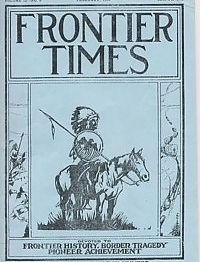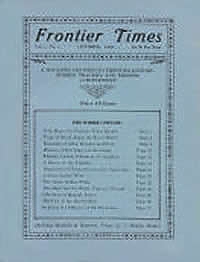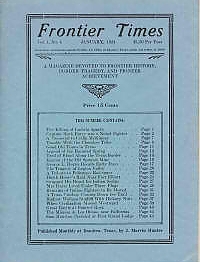By using our website, you agree to the use of cookies as described in our Cookie Policy
Magazines & Instant Downloads
Vol 12 No. 05 - February 1935
A Texan's Opportunity
By Max Coleman, Lubbock, Texas.
Story of a cowboy opportunist, John B. Kendricks. He grew up to young manhood in South Texas in the heart of the open range. He rode night herd around cattle, lulled by the roar of the waves of the Gulf of Mexico. The climate was so mild that he slept out practically the year round, and for two thirds of the year, a saddle blanket was sufficient bedding. In 1879, he was hired to drive a herd of cattle to Wyoming. At that time, the trail was practically uncharted and very few herds had made the trip. Trail Boss was a combination Czar, friend, doctor, and dentist for his men. His word was absolute law as their very lives might depend on his judgment. No fence was encounted on the trip, and only a few trappers cabins. The Indians were only half tame and frequently demanded cattle for tribute. The cattle were allowed to take their time so as to arrive in good flesh and slowly the outfit made its way North, traveling from ten to twenty miles a day. They passed the Mexican village of San Antonio, and a small settlement called Fort Worth, then leaning to the Northwest, crossed the Northern edge of the staked plains, then the Canadian River, later the Arkansas and South Platte and on to Wyoming – the new frontier for cattle and the livestock industry. John B. Kendrick studied the country, the climate, and endeavored to overcome the natural obstacles and to make use of the advantages existing in every new frontier country. Occasionally winters would come and it would seem that the entire herd would be wiped out. But he persevered and finally established an ideal ranch of his own and his famous OW brand became known all over the Northwest. This is the story.
Further mentions: He was elected State Senator on the Democratic ticket and later served as Governor of the State * the Texas and Southwestern Cattle Raiser's Association * American Livestock Association *
PIONEER BARBER SILENT WORKMAN IN MULLIN SHOP
Brief account of Dave Eaton of Mullin, TX, who alternated his barber work with employment as a cowhand, worked on the range for 20 years, part of the time for the A-ranch near Lamesa and for two years was at the point of the Guadalupes for A. F. From a silent man of the range to a silent man behind the barber chair.
Further mentions: Zephyr * Crawley * Pecos City * Dr. Herrington * A. E. Hancock * B. J. White * Midland * ke Mullin, who also had a ranch near Veribest, in Tom Green county * Mullin Enterprise *
Trials And Thrills Of Early Travel
Fascinating account of conditions faced by those who journeyed on the route from San Antonio and San Diego in 1868.
Mentions: Ernest L. Brown * G. H. Giddings * George L. Haseltine, deputy tax collector of Pecos County * the Alamo National Bank * H. E. Doyle * James J. Giddings * The city of Giddings, in Lee County, now a center of modern transportation, was named after the early family * Passengers were given a guarantee that they would ride in coaches all but 100 miles in the Colorado desert. This little jog was crossed on mule back. * Fort Clark at Brackettville * Eagle Pass * the G. H. & S. A. branch of the S. P. * . D. E. Genard, of San Antonio * Mr. W. G. Grant, managing editor of the San Antonio Express * the Overland Stage Line *
When The Express Service Was Young
By Stanley W. Todd.
Ever wonder where UPS and Fedex got there start? This is the EARLIEST history of the express service – it’s origin, development and the transition from stagecoach to the railroads as conveyance. Here is excellent history indeed!
Further mentions: an enterprising young man, William F. Harnden * Henry Wells * William G. Fargo * the American Express Company * the Adams Company * Hannibal * William F. Cody (Buffalo Bill) *
Padre: Island Of Romance And Buried Gold
By Coleman McCampbell
Very excellent account of early history and development of the longest of Gulf coast islands, and the place of many formidable events in the building of this great state. Also mentions its legends of buried gold. Pirates and freebooters touched its shore; there were shipwrecks; it was a rendezvous for smugglers; and before the Spaniards came it was inhabited by Indian tribes. Here is some great history.
One of the legends has to do with two strangers who arrived in Corpus in the summer of 1893. They hired a boat to go to Padre. To all outward appearances they were equipped for a fishing trip, bent on hooking tarpon or catching a fine mess of red fish and mackeral. But it developed that they were looking for the treasure. An aged Mexican had told them a Spanish vessel stranded there in the early 1820s. The captain and the crew, it seems, abandoned the ship and buried gold in three different places. While wandering over the island they were captured by Indians. The two strangers had only limited success. "They found gold coins dated 1721, 1736, 1738, 1761, and silver coins of a much later date. Shifting sands, however, have removed all trace of the main treasure. It may still be there!
Further mentions: Patrick F. Dunn * Col. Sam Robertson * the Jones Brothers of Kansas City * Penescal, below Corpus Christi * the Don Patricio causeway * Laguna Madre, third most saline body of water in the world * Bird Island
JUST ONE DUDE RANCH IN TEXAS
Texas, the biggest ranching State in the Union, has just, one dude ranch, the Gallagher ranch near San Antonio…
Expedition Through Unexplored Texas In 1854
By W. B. Parker. (Continued from last month)
Another installment in a series of lengthy and detailed articles where the author shares his experiences while attached to the expedition commanded by Captain R. B. Marcy, to explore Northwest Texas in the Summer and Fall of 1854. Fascinating eye-witness & day-by-day journal of events on early frontier. One of the many excellent things the writer details, is the manner of provision while on the trail. In many places, he goes into great detail regarding the hunting and fishing that was necessary for their survival. You will be surprised to hear of some of the adventures this afforded. (We can provide you with the rest of the installments in this excellent series - just ask)
Further mentions: our guide, John Conner * John Jacobs * the Little Witchita * the Belknap road * John Hunter, the Shawnee *
Flagstaff, The Last Big Cowtown Of The Old West
By Earl R. Forrest
As a cowtown Flagstaff reached the height of its glory during the years that followed the coming of the Arizona Cattle Company in the 1880’s, and Babbitt brothers with the C. O. Bar in the nineties and early years of the 1900’s. As a cowtown, it had its typical vices and a large part of its population lived mainly of the vices of the range; and saloons, gambling dens, dance halls, and red light resorts across the track ran full blast night and day. It had its bad men and its good; but bad and good-gunmen, gamblers, bartenders, dance hall girls, peace officers, ministers, cowboys, and lumberjacks-Flagstaff made room for them all. Such was life in the old Southwest. This is the account of the once, major cow-town of Arizona.
Further mentions: The Atlantic & Pacific Railroad * Observatory Hill, * P. J. Brannen * ndy Donahue's, Torte's, Senate Saloon, Black's, the Curio, and Otto's Place * Flagstaff's "Boot Hill" * Johnny Berry, a saloon keeper of early days * William Rhodan, one of the old-time cattle kings of Northern Arizona * George and William Hawks, two bad men * William Lamb * a young cowboy known as the "California Kid," * J. Y. Crothers and William West * Thomas Swearingen * Dan Davis * the camp of Kennedy and Holzman * Campbell's Spring, sixty miles south of Flagstaff * Lyman Drum * Railroad Street * The big fire of February 14, 1886 * William Bidinger * Berry's saloon * W. H. Ashurst, a prominent cattleman *
Two Unusual Monuments And Boothill
By Charles A. Gianini
Two monuments standing on the graves of pioneer miners are to be found, one near the dead mining town of Tombstone in the southeastern corner of Arizona, and the other in Cooney Canyon of the Mogollon Mountains of southwestern New Mexico. The graves are those of Ed. Schiefflin who had been a scout in government service, working over the country south of the Dragoon Mountains, and James C. Gooney, also a military man turned miner. This is the account of their sad experiences in the region.
Further mentions: the Town of Tombstone * the Mogollon Mountains * Gen. Devine * Fort lanyard * Victorio with his Apaches * Gooney Canyon * a man named Jack Chick * the little town of Alma * Judge B. L. Peel
Diary Of An Early Day School Teacher
INTERESTING diary of the early Indian days around the Fort Hubbard settlement on the Clear Fork of the Brazos, some twenty miles above the present location of Eliasville, Texas, was published in the Graham (Texas) Leader, January 29, 1922, and is reproduced here. Fort Hubbard was first called Fort Davis, and was located in Stephens county, just across the line from Shackelford county, and on the east bank of the Clear Fork. The diary was kept by Sam Newcomb, who taught school there during 1865. Here are some excerpts from the teacher’s diary:
January 1, 1865--For the past year Indians have been troublesome, coming into the section in such large bodies that a great many families have left the frontier and moved into the older settled. counties, and those who remain are "forted up". There are now 125 persons in the fort and others are preparing to move in.
March 12--Indian excitement has been high here today. About 9 o'clock this morning Mr. McCarty came upon a large body of Indians about three miles from the fort. They gave him a close chase, but he reached the fort all right. The Indians were followed all day, but made their escape. I think this will stir some people in this place to do their share of picketing.
March 13--Commenced school here today for a term, of fourteen weeks. I have only nineteen scholars at present, and most of them are rude, wild, and wholly unacquainted with school discipline.
March, 22--A man by the name of Scott reported to be in this section of the country with forty-five hands gathering all the beef cattle he can, and giving nothing in but a quartermaster's receipt in payment for them.
August 15-- there was considerable excitement in the fort over what seemed to be a well authenticated report to the effect that the United States, France and Mexico had gone to war and fought a number of battles.
August 26-- There will be no preaching here, tomorrow, as the people had expected. There are several persons here, grown, married and single.
November 29-- A large buffalo was driven into the fort this morning, causing a great deal of commotion and excitement. The animal was immediately attacked by forty dogs and killed in a very few minutes.
December 5-- Cold and sleeting and several herds of buffalo drifted by during the day. I have stood in the school house and watched a herd not more than one hundred yards away. I have made some home-made ink, but find it difficult to get it of the proper color and consistency, but it is a case of the best you can do or do without.
Further mentions: T. B. Brownfield * Belknap * Miss Lucinda Selman * Camp Cooper * Hubbard Settlement, and Fort Davis * Parson Slaughter * Mr. Frans * Lynch's ranch on Hubbard * G. T. Reynolds and S. Huff * W. R. St. John * Mr. Newcomb * Mariet Sutherlin * Weatherford * W. B. Hoover * Hitson * J. C. Lynch * Lindsey * B. W. Reynolds * the old Stone ranch * Mr. Mosely * Mr. Hoover
Historical Fort Davis
By Mrs. W. B. Hamilton.
At the foot of the "Crouching Lion" mountain in the range known as the Davis Mountains lie the ruins of this formerly powerful government stronghold, Fort Davis. This account traces it’s glorious history from the days when, in 1535, De Vaca, the Spanish adventurer, headed an expedition that came through the Big Bend and Davis Mountain country in search of gold and rich minerals, and on through it’s days of notable usefulness on the Texas frontier and the Big Bend country.
Further mentions: Fort Davis was established by the War Department, October 23, 1854 at what was then Comanche Painted Camp, on La Limpia Creek, 475 miles northwest of San Antonio and 220 miles sortlieast of El Paso * During the Civil War, the Confederacy had charge of the fort. It was reoccupied by federal troops in command of Lt. Col. Wesley Merritt, July 1, 1867
FIVE POINTED STAR DATES BACK TO 1835
The five-pointed star, as the emblem of Texas, dates back to 1835 when...
History Of The Texas Navy
EDITOR'S NOTE-This "History of the Texan Navy" is from a frayed copy of the TEXAS ALMANAC of 1860, and is reprinted by the courtesy of U. B. Dealey, president of the A. H. Belo Corporation, publishers of THE ALMANAC. The authorship of the article was not given, but it quite evidently was written by a person thoroughly familiar with the subject, treated. Enjoyable reading is to be had from this account of the combats of the ''Liberty," the "Invincible," the "Independent," and the "Brutus."
Further mentions: Quintana * Velasco, at the mouth of the Brazos * Win. Robbins * Copano * Thomas F. McKinney, a Captain in the Navy * Capt. Jere Brown * D. G. Burnet * Hon. Samuel Swartout * Commander H. L. Thompson * Commander I. D. Boylan * , S. Rhodes Fisher * Yookun * Vincedor Del Alamo * Capt. Wheelwright * Mugeres * the Mexican schooner Obispo * the schooner Telegraph * Another vessel, the Eliza Russel * Alicranes * Col. John If. Wharton * the banks of Campeachy
HOSTILITIES CEASED IN 1843
It is interesting to note that, while by the victory at San Jacinto Sam Houston and his army achieved Texas' freedom in 1836, actual permanent cessation of hostilities between the Republic of Texas and Mexico did not come until 1843, and then mainly as a result of the disinclination of a Texan to continue his sojourn in a Mexican prison. And had Santa Anna been willing to grant such terms, to Texas in 1835 as he proposed to them voluntarily in 1843, possibly there would never have been a declaration of independence.
Among the prisoners taken by Gen. Adrian Wolf in his raid on San Antonio, in September, 1842, was James W. Robinson, who had been Lieutenant Governor under the Texas provisional government…
OLD TRAIL DRIVER DEAD
Celestin Villemain, aged 91, pioneer and trail driver, who served as city tax collector for San Antonio from 1905 to 1915, died in San Antonio December 20. A native of Bellefourd, France, the son of Michael and Catharine Villemain, who also were natives of France. Villemain as a boy of 10 accompanied his parents to Texas in 1853 and settled in Bexar county, where they established a farm and stock ranch on the Medina river. He became engaged in freighting with ox teams between San Antonio and Port Lavaca and continued with success for a number of years…
Further mentions: William Krempkau, organizer of the Pioneer Freighter's Association * the Old Trail Drivers' Association
A. L. McCOY DEAD
Friends throughout, Western Texas mourn the death of A. L. McCoy, who passed away at his home in San Saba, Texas, December 28, last. We are in receipt of a card from his daughter, Mrs. Annie Duncan of Richland Springs, Texas, informing us of his death. Mr. McCoy was born in Burnet county, Texas, December 11, 1854, and was 80 years old. He served as a Texas Ranger in 1872 and 1873 with Captain Alexander, the company being made up of men from the counties of Burnet, Lampasas, Llano and San Saba. He was in several Indian fights and one in which death looked almost certain to the group was the Morgan fight which took place thirteen miles north of Burrret. Mr. McCoy and his comrades were led into a trap set by the Indians, but fortunately none of the men were killed. Several of the Indians bit the dust. In addition to his ranger service, Mr. McCoy made several trips up the trail with cattle. In 1884 he and Mack Pryor, a brother to Colonel Ike T. Pryor of San Antonio…
Further mentions: the Waffinay river near Pueblo, Colorado * two daughters, Lindsey and Dee McCoy, Mrs. Annie Duncan of Richland Springs, Willie McCoy and Mrs. Allen Peterson of Llano,; seven brothers and two sisters; Hugh McCoy and W. R. McCoy of Burnet, Tom W. McCoy of Menard, A. F. McCoy of Brady, B. J. McCoy of Haskell, J. R. McCoy of Chinook, Montana, W. II. McCoy, Mrs. Vina Stewart and Mrs. S. J. Riggs of Burnet
A. B. Macdonald, Veteran Reporter
Story about A. B. Macdonald, veteran reporter on the Kansas City Star Macdonald's job was a peculiar one. He selected practically all his own assignments. Suggestions came from various editors, but for the most part his stories came from his own hunches. He was supposed to write a story a week--good enough to make page one of the Sunday magazine. The Star paid all expenses. His stories were the only ones signed throughout the entire paper. His was one of the nicest jobs in the newspaper game. He would go out and get his story, return to his home, write it leisurely and when finished take it, down to the Sunday editor. His greatest forte was in his simple terse style and his nose for news, which was just short of being phenomenal.
Further mentions: the Tampico field in Old Mexico * Mr Foster * the Mary Sudik wild well * Mrs. Payne, wife of a prominent lawyer, riding into town in her coupe, was blown to pieces * Gene Howe, editor of the News-Globe * Roy Roberts, managing editor of the Star * Miss Verona Thompson * Borger * Canyon City * Pampa * Tascosa * Leo M. Frank * Mary Pliagan *
Flood In Colorado River In 1869
By Emma L. Wofford
In JULY, 1869, there came a flood in the Colorado river that was said to be the highest ever known, even by the oldest inhabitant. This brief story is about the Davis plantation, at the Montopolis ford, then inhabited by Reverend J. H. Wofford and his Davis half-sisters and brothers.
Further mentions: "Miss Emily" * "Uncle Len," *
HONORING LARRY CHITTENDEN, THE "COWBOY POET"
A movement is on foot in Jones county to commemorate the "Cowboys' Christmas Ball," written by Larry Chittenden, the "Cowboy Poet," by a joint gathering of the citizens of Hamlin and Anson. The famous "Cowboy Poet," lived on a ranch between the two Jones county towns and was extremely popular with the citizens of both. It was his custom while alive to remember the Anson high school with a Christmas gift of some of his books. The Anson Parent-Teachers' Association began with the last Christmas to remember each year this English poet who was an early Texas settler. The feature of the observance is to be a mass singing of one of the poems which spread his fame over the Southwest and thence throughout the Nation, "The Cowboys' Christmas Ball." The gymnasium of the Hamlin high school was the setting for the first of the series.
GOOD WORDS FROM GENE
Eugene Cunningham, novelist, western story writer, and literary editor of the El Paso Times, never misses an opportunity to say a good word for Frontier Times. Here's what he said in the El Paso Times December 30, 1934…
Mentions: Eugene Cunningham, Mr. and Mrs. N. C. Patterson, F. Routledge * Guy J. Giffen * Dr. I. L. Van Zandt and Mrs. Ida Van Zandt Jarvis * Van Zandt
Some names mentioned in this volume:
Alvin Adams; Capt Alexander; Allen; W. H. Ashurst; A. H. Belo; Johnny Berry; William Biddinger; Com I. D. Boylan; Bracht; P. J. Brannen; Brewer; Ernest L. Brown; Capt Jere Brown; T. B. Brownfield; J. H. Browning; D. G. Burnet; William Burns; Castaneda; Chabot; Jack Chick; Chittenden; Clark; William F. Cody; Coleman; Conner; James C. Cooney; A. F. Crawley; J. Y. Crothers; Cunningham; Dan Davis; G. B. Dealey; Gen Devine; Dobie; Sandy Donahue; Conan Doyle; R. E. Doyle; Lyman Drum; Annie Duncan; Patrick F. Dunn; Earp; D. B. Eaton; Dave Eaton; Capt Charles Elliot; Emmett; William G. Fargo; S. Rhodes Fisher; Earle R. Forrest; Dep Sheriff Francis; Leo M. Frank; J. M. Frans; D. E. Genard; Charles A Gianini; G. A. Giddings; G. H. Giddings; ; James J. Giddings; Guy J. Giffen; Gonzales; W. C. Grant; Horace Greely; Green; Grey; Haley; Mrs W. B. Hamilton; A. E. Hancock; William F. Harnden; George C. Haseltine; George Hawks; William Hawks; Dr Herrington; John Hitson; Sherlock Holmes; Phillip Holzman; W. B. Hoover; Gene Howe; S. Huff; J. Warren; T. E. Jackson; John Jacobs; John Jacobs Jr; Ida Van Zandt Jarvis; Van Zandt Mayor ; Sam Johnson; John B. Kendrick; John B. Kendricks; William Krempkau; William Lamb; Lemley; Lewis; Sam Lindsey; J. C. Lynch; A. B. Macdonald; Macdonald; Marcy; McCampbell; Angelina McCarty; A. F. McCoy; A. L. McCoy; B. J. McCoy; Dee McCoy; Hugh McCoy; J. R. McCoy; Lindsey McCoy; Tom W. McCoy; W. H. McCoy; W. R. McCoy; Willie McCoy; Thomas F. McKinney; Col Wesley Merritt; Miller; Ike Mullin; Sam Newcomb; Constable Odell; Parker; Parks; Mrs N. C. Patterson; Peak; Judge B. L. Peel; Mrs W. A. Peril; Mrs Allen Peterson; Mary Phagan; Dep Sheriff Powell; Col Ike T. Pryor; Mack Pryor; B. W. Reynolds; G. T. Reynolds; William Rhodan; Mrs S. J. Riggs; Wm Robbins; Roy Roberts; Col Sam Robertson; Lt Gov James W. Robinson; Rose; F. E. Routledge; Eliza Russel; Ed Schiefflin; ; B Schon Schmidt; Scott; Lucinda Selman; Parson Slaughter; Smith; W. R. St. John; Vina Stewart; Mary Sudik; Mariet Sutherlin; Hon Samuel Swartout; Thomas Swearingen; Capt Thompson; Com H. L. Thompson; Verona; Stanley W. Todd; Dr I. L. Van Zandt; Isaac Van Zandt; Victorio; Catharine Villemain; Celestin Villemain; Michael Villemain; Henry Wells; William West; Col John H. Wharton; Wm H. Wharton; Capt Wheelwright; B. J. White; Louis T. Wigfall; Williams; Wofford; Emma L Wofford. ; Rev J. H. Wofford; Woll; Woodhull.
$4.95
‹ Back








